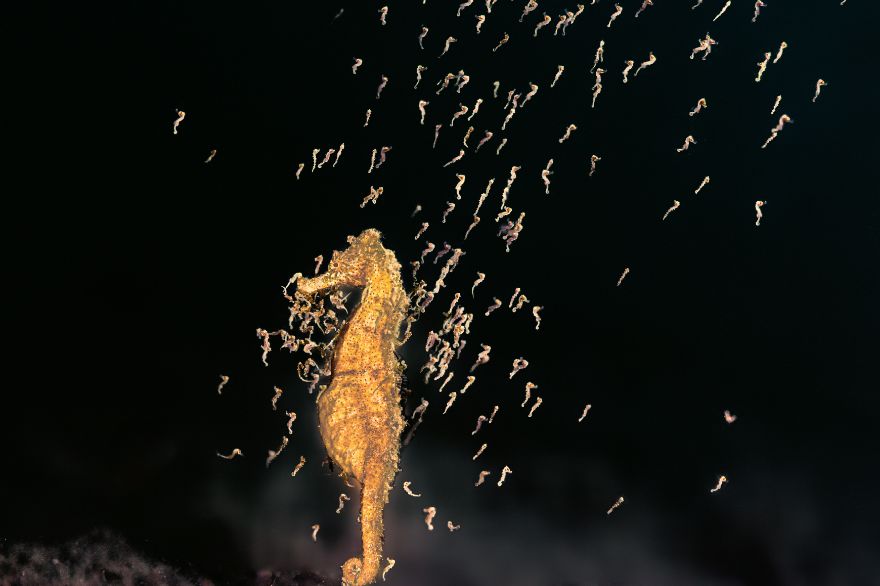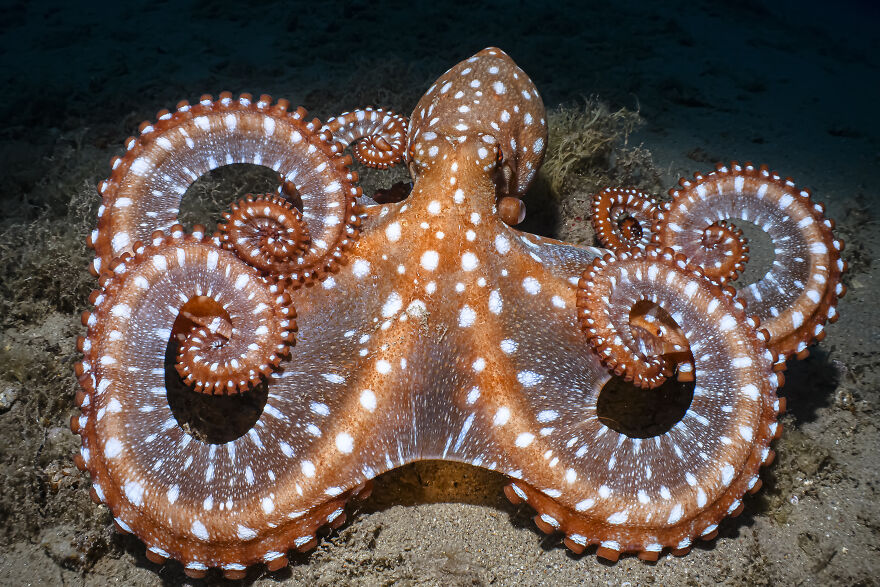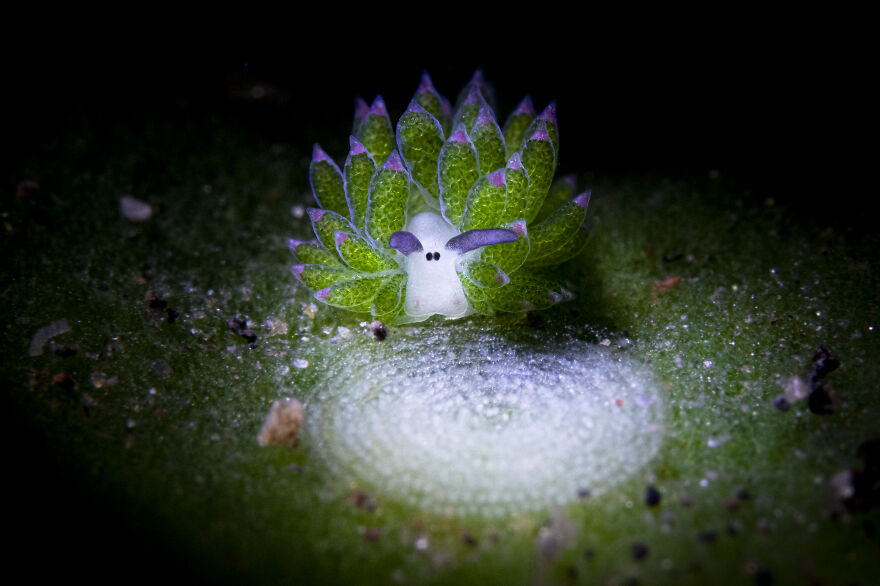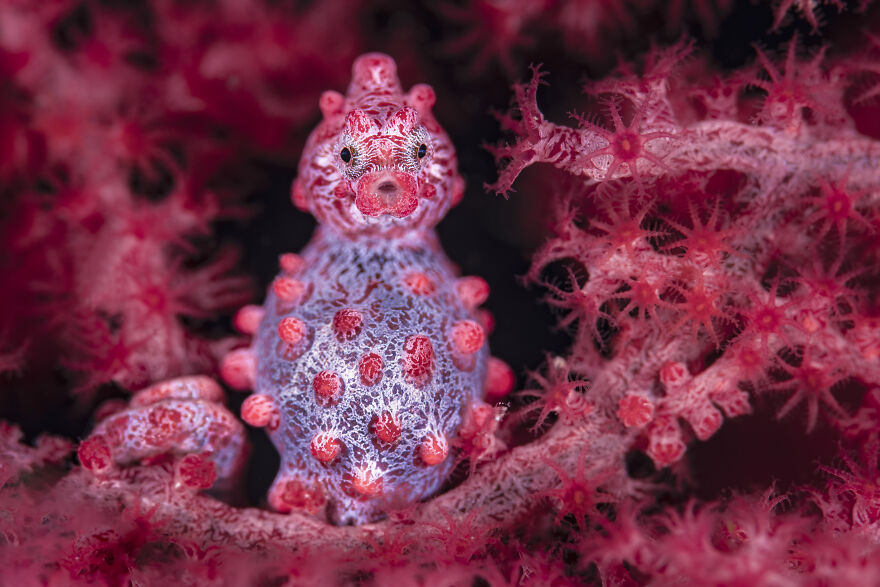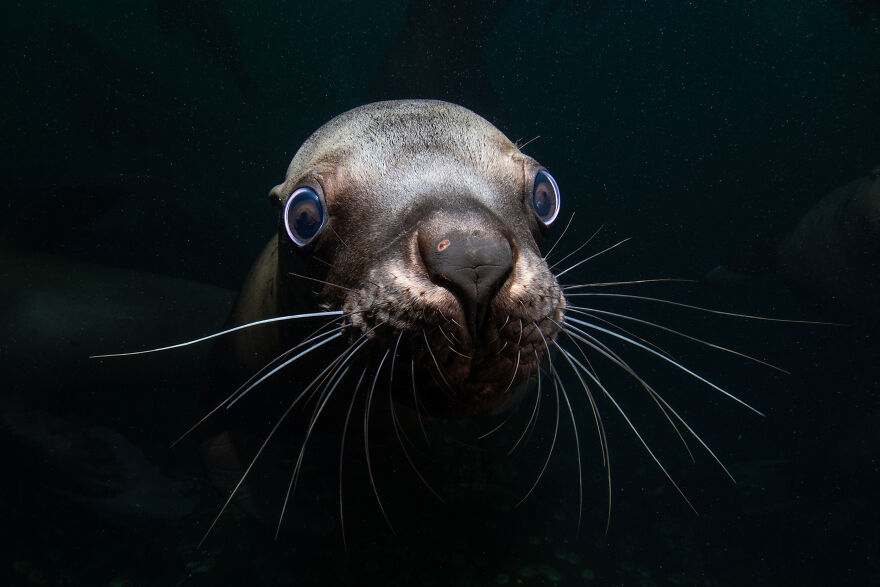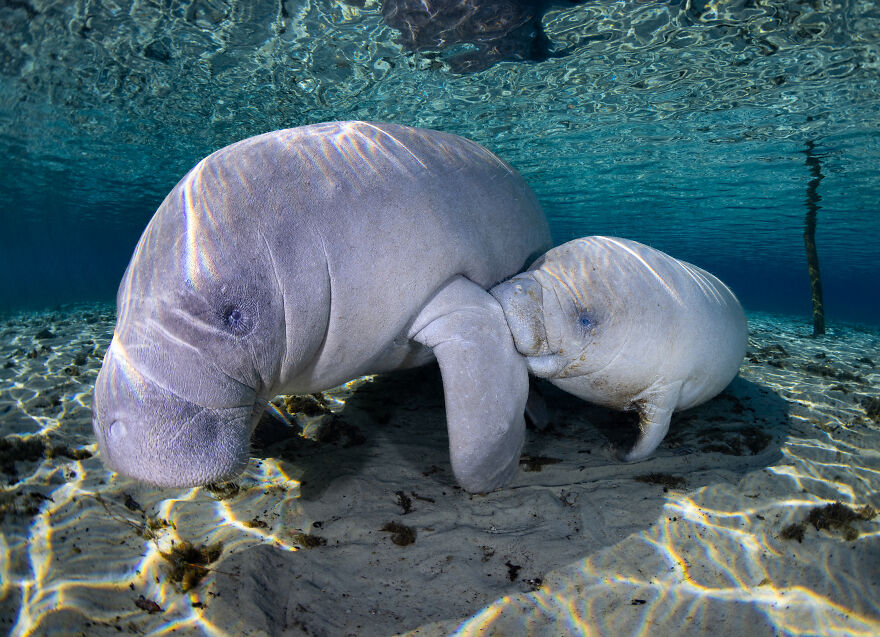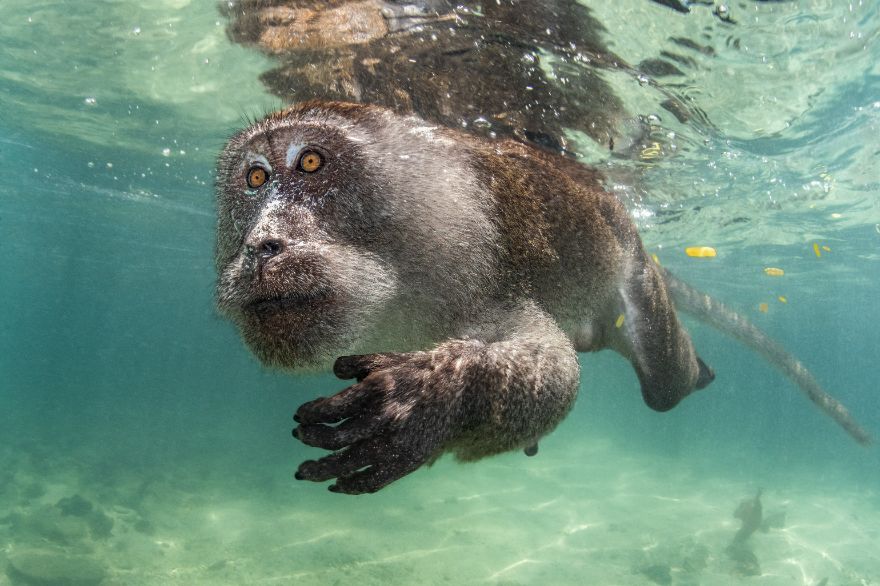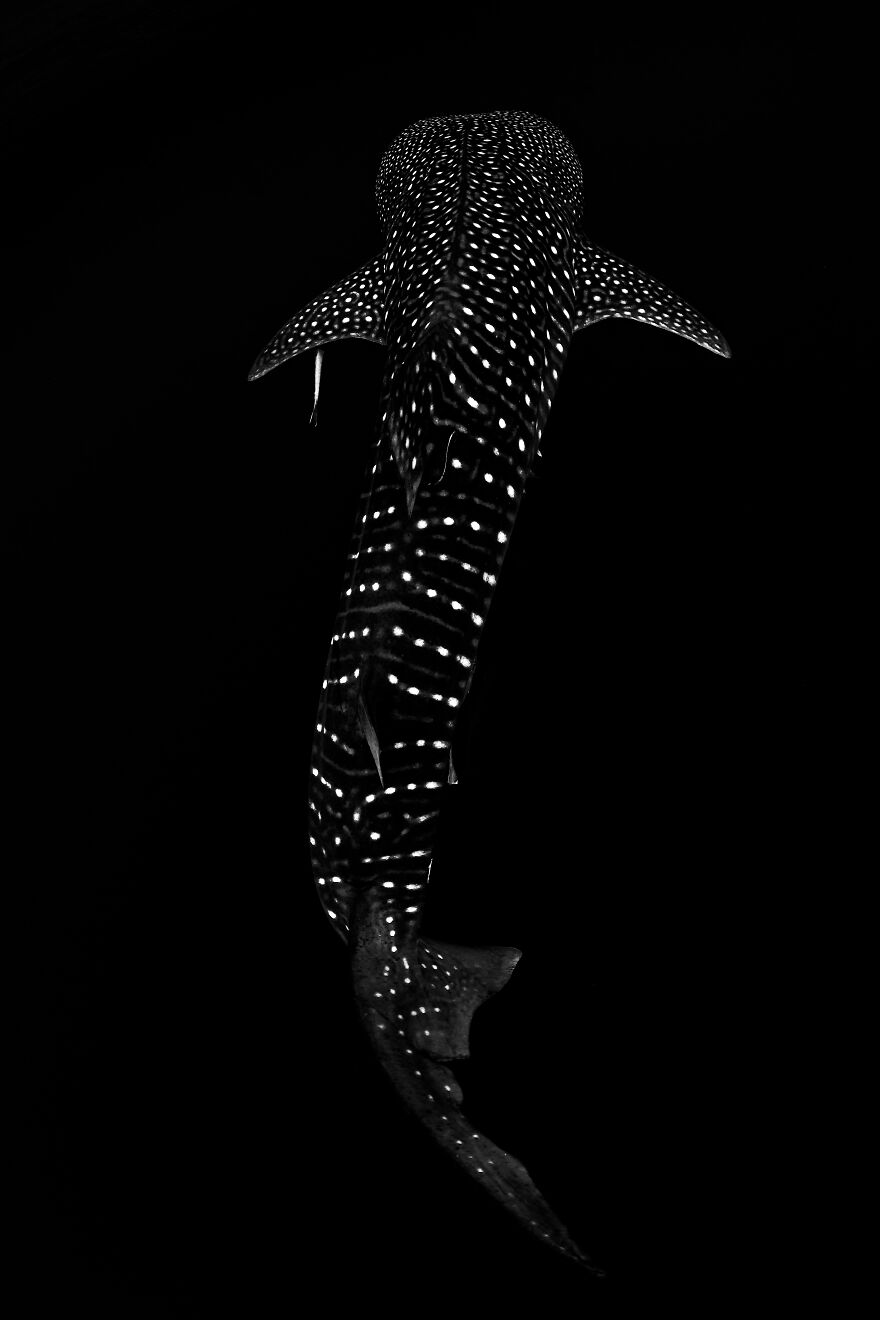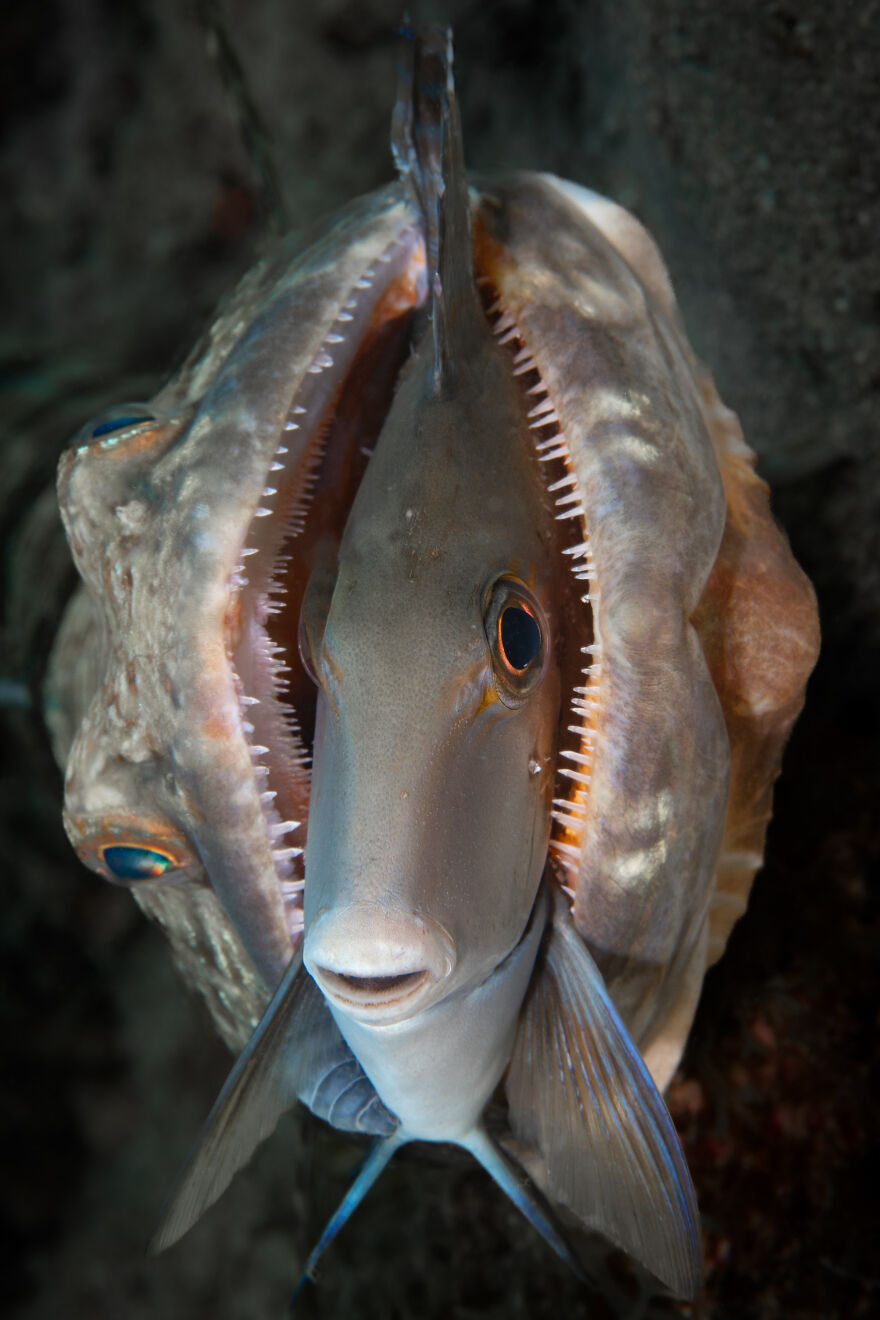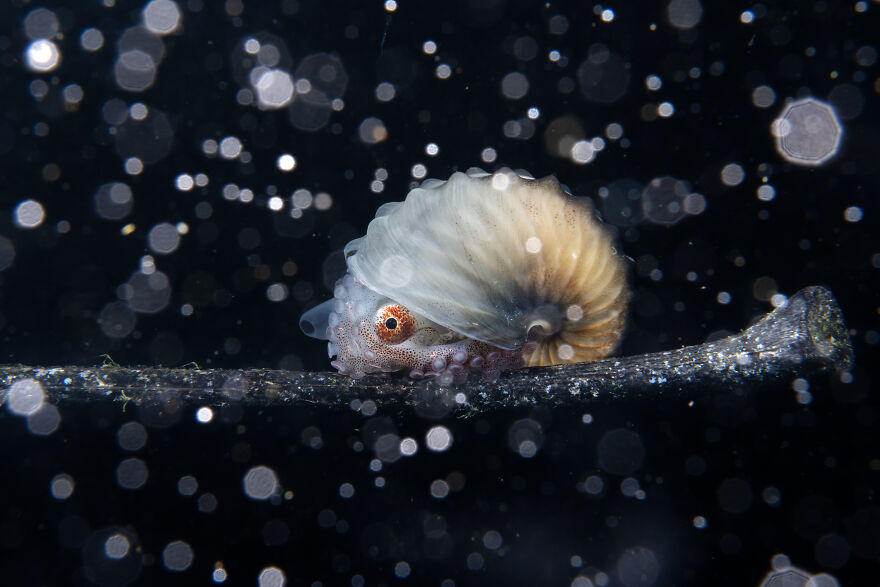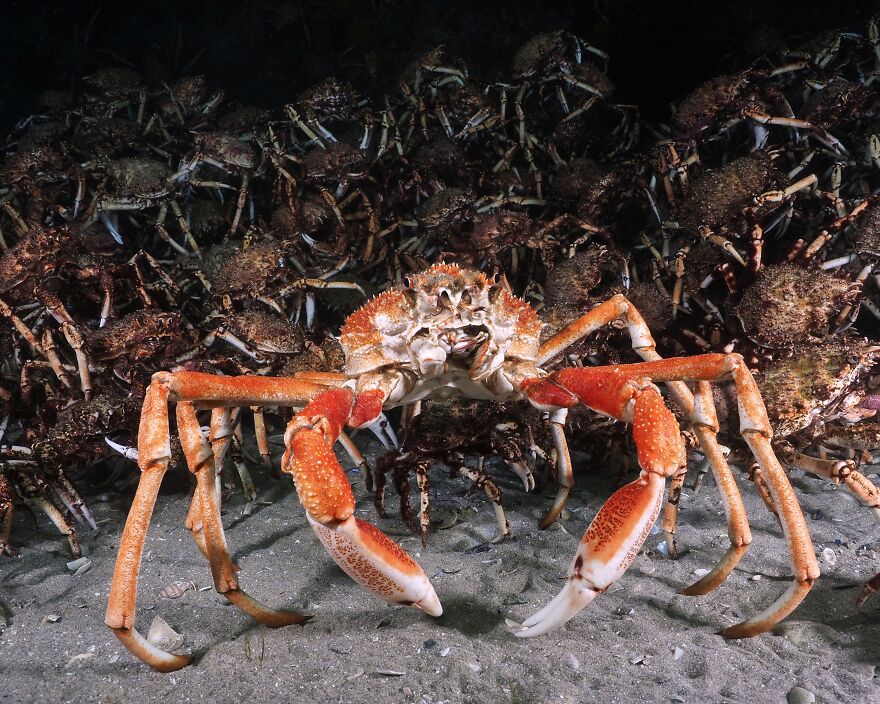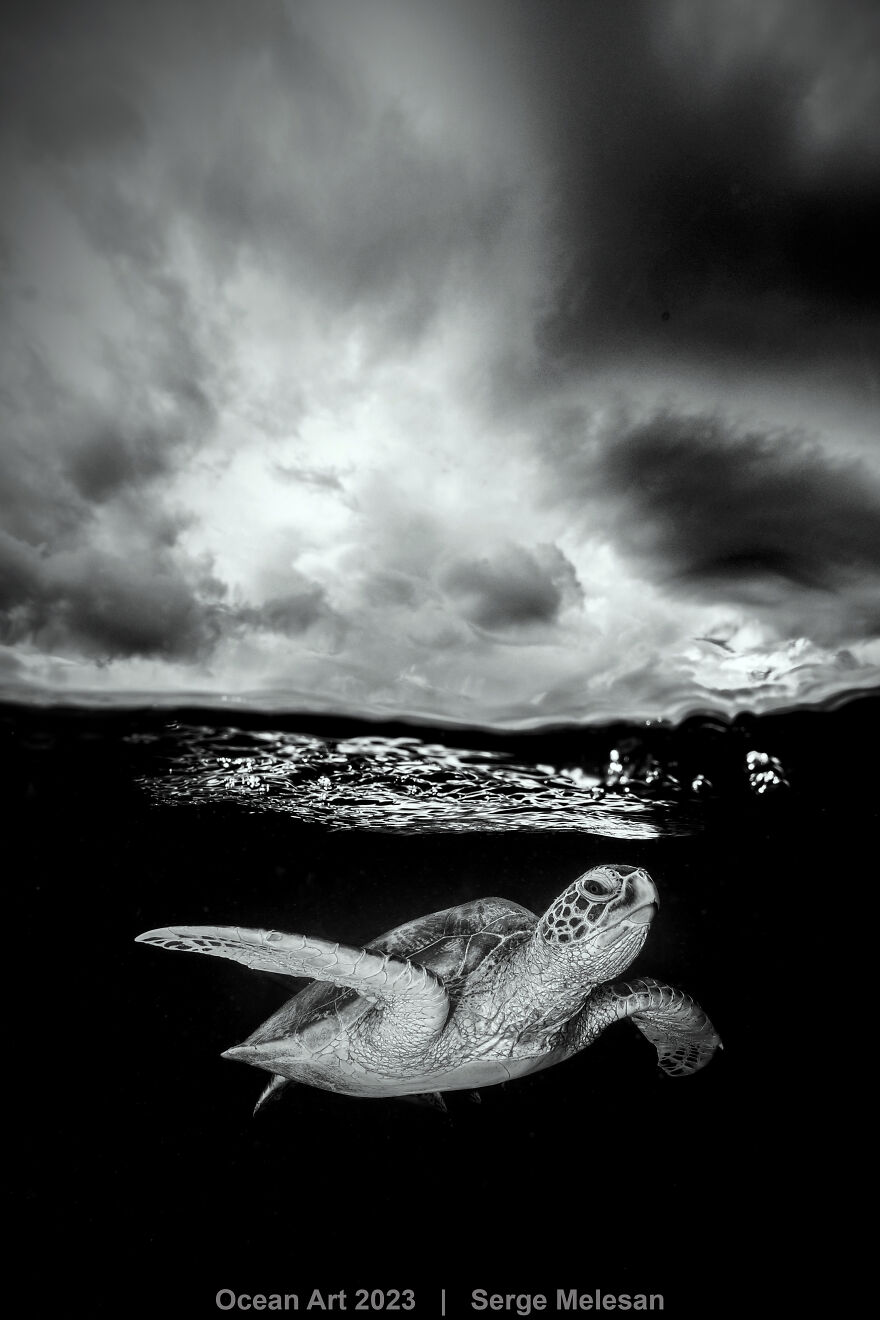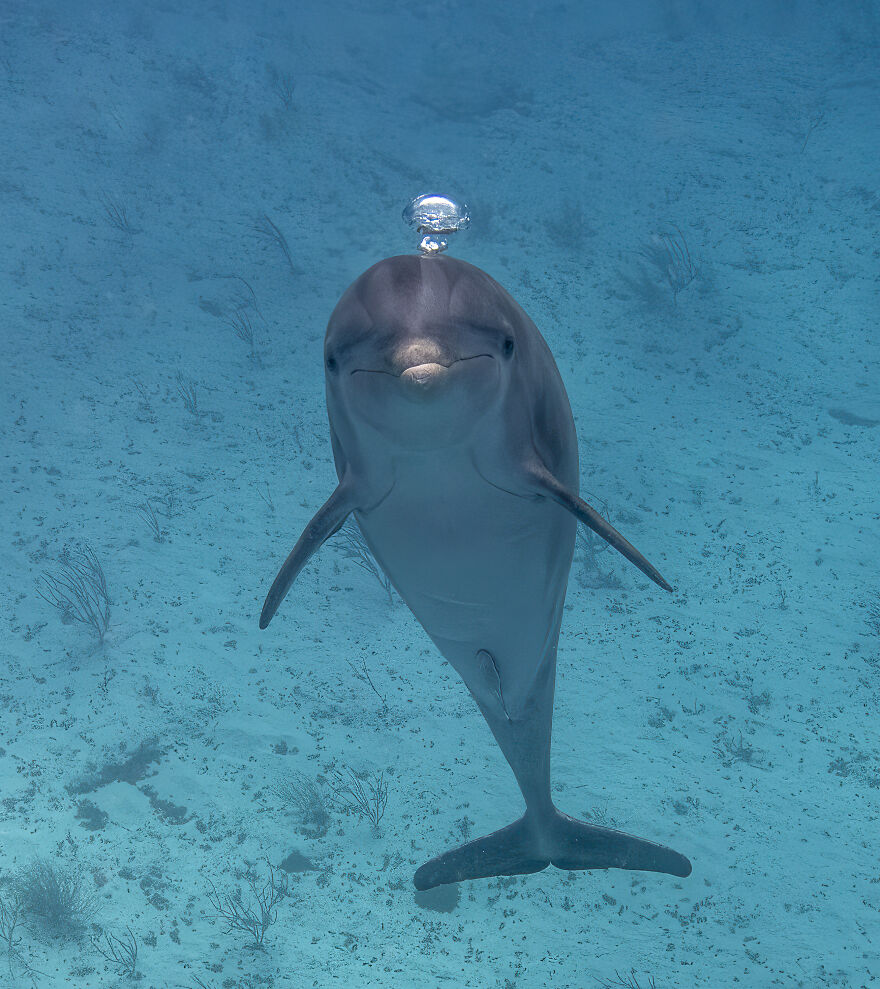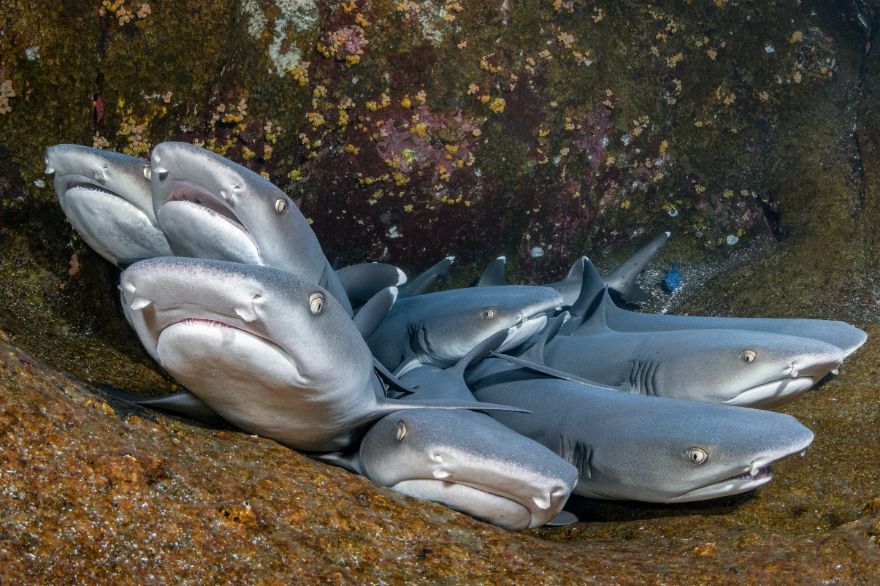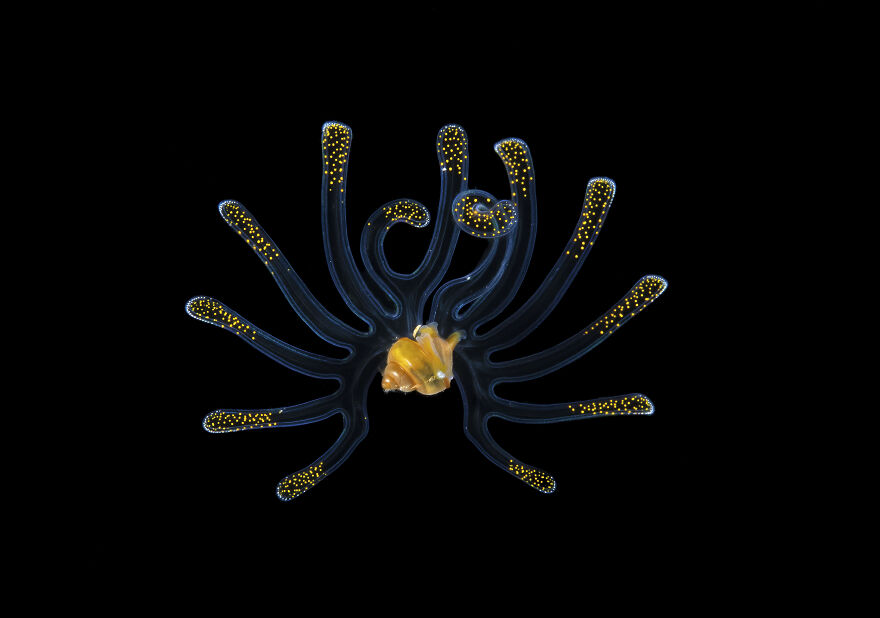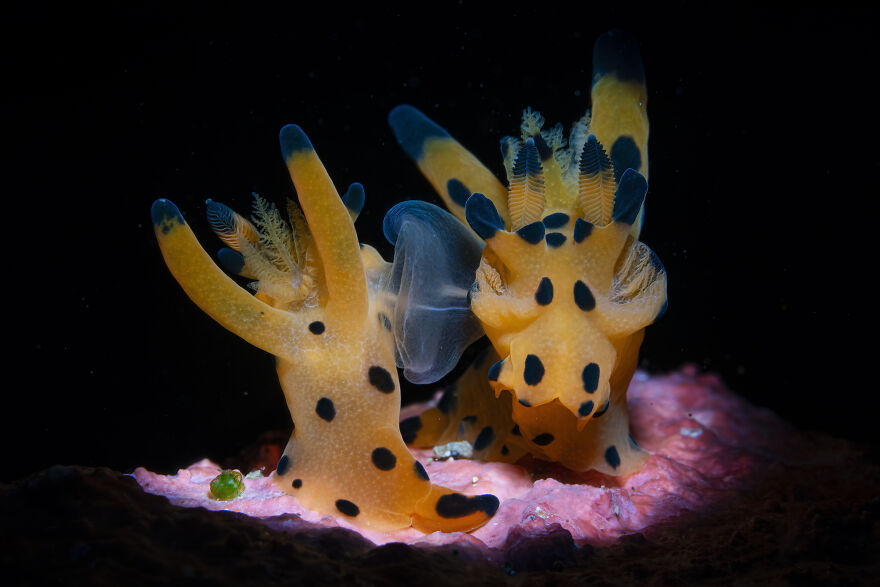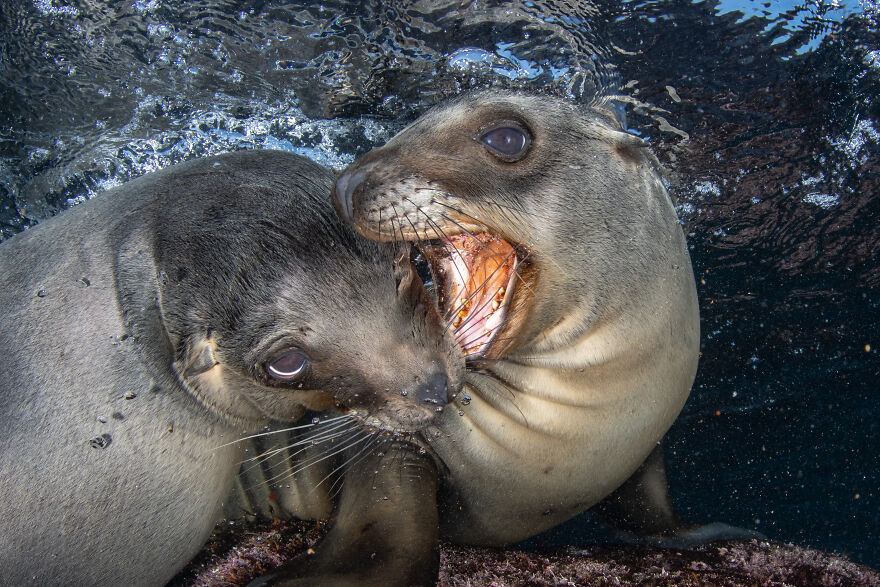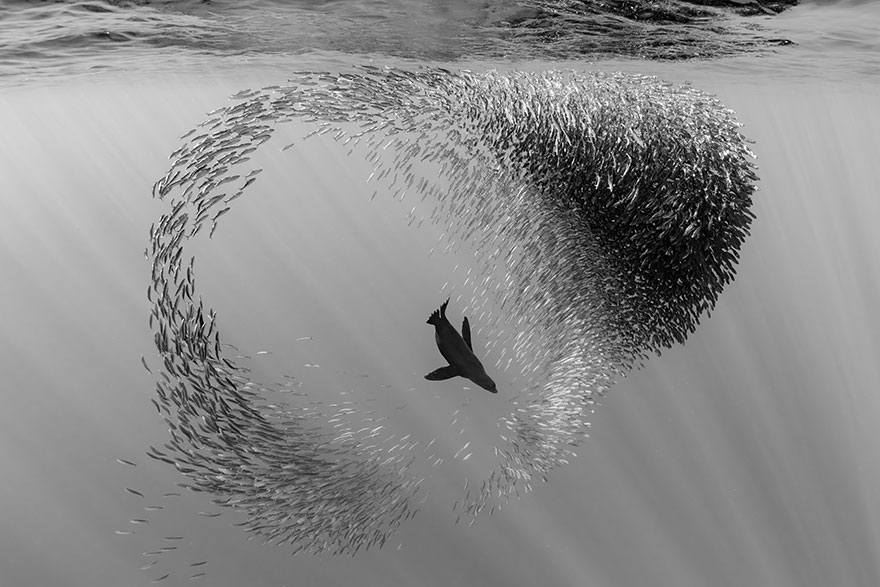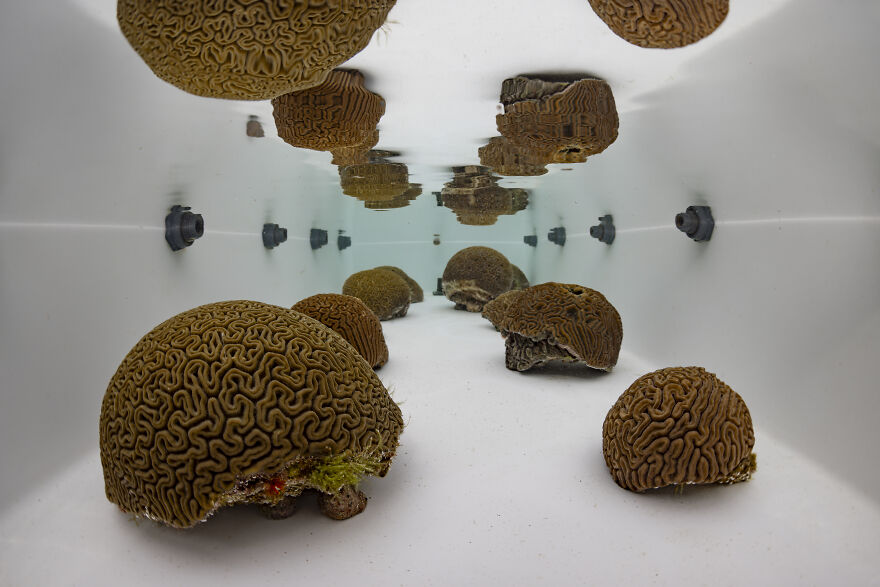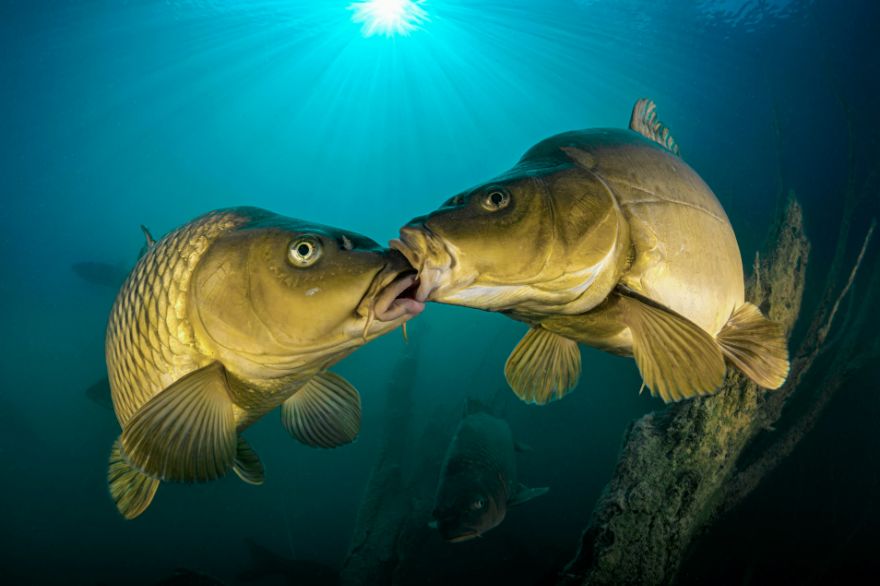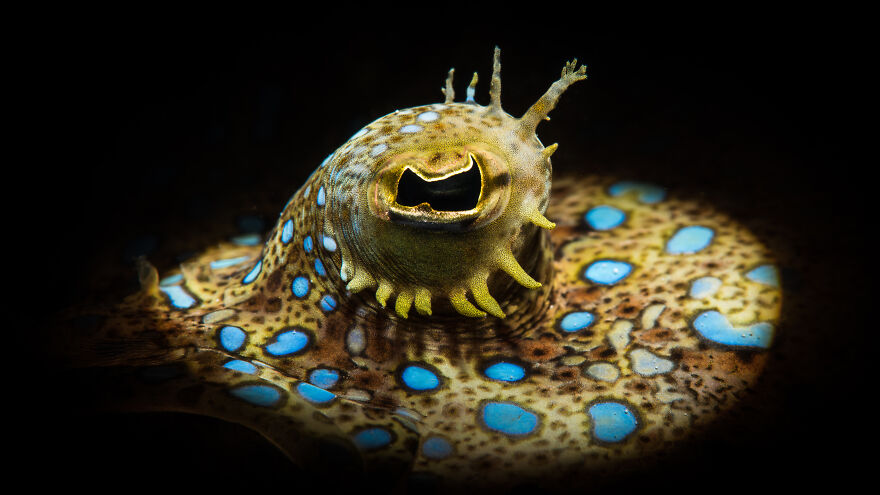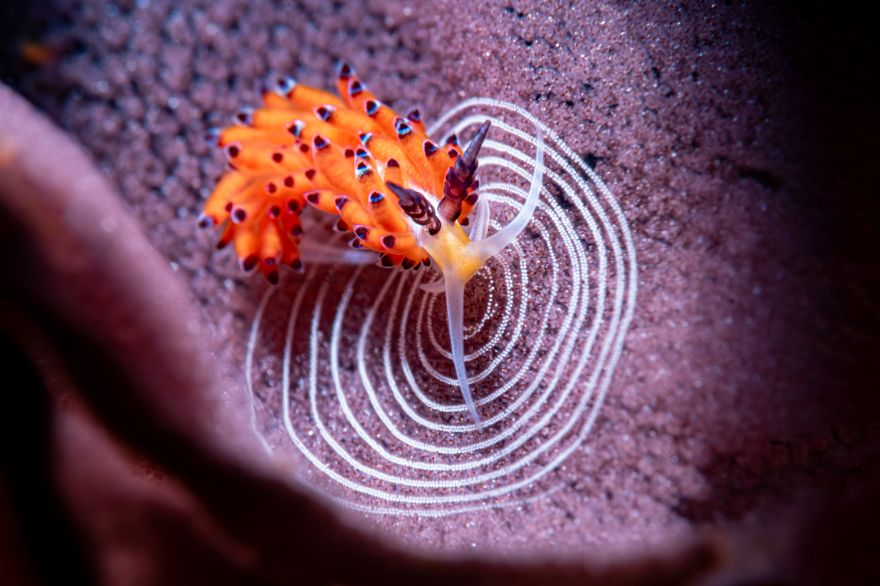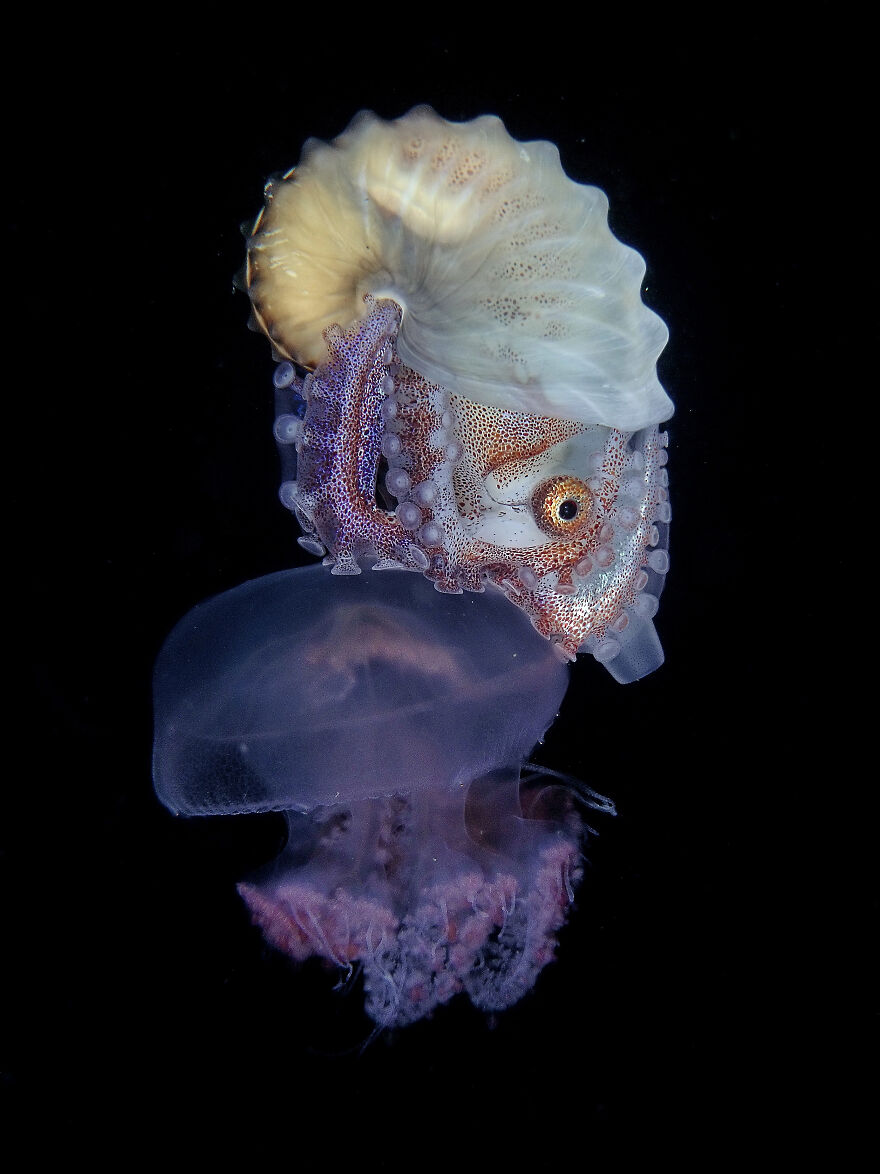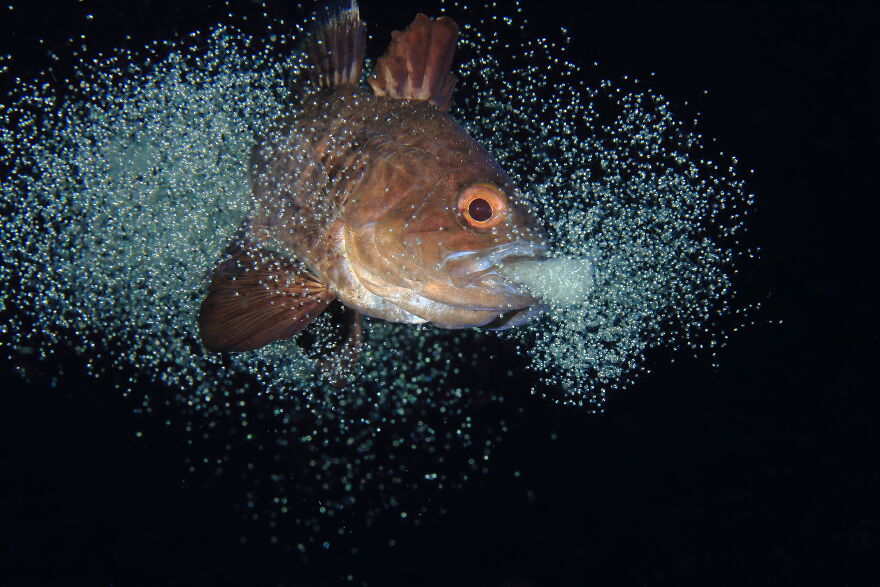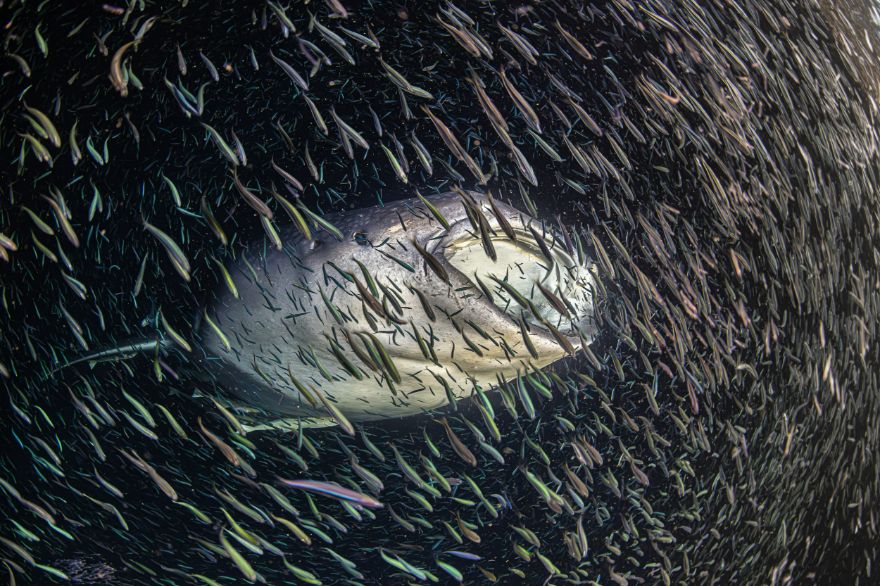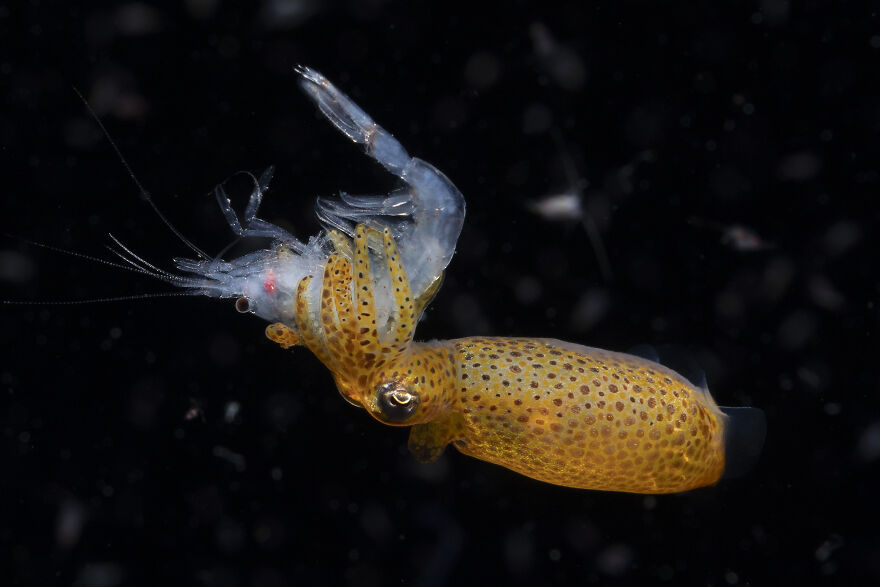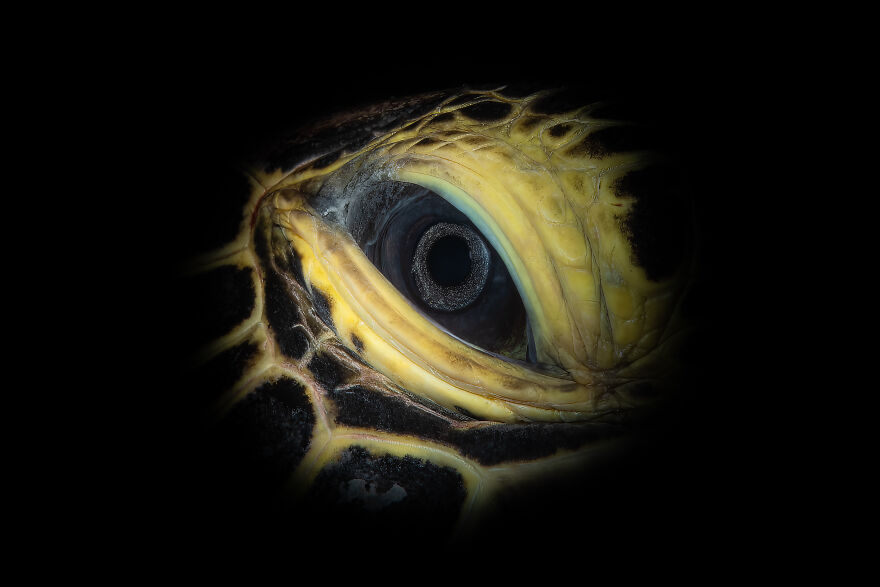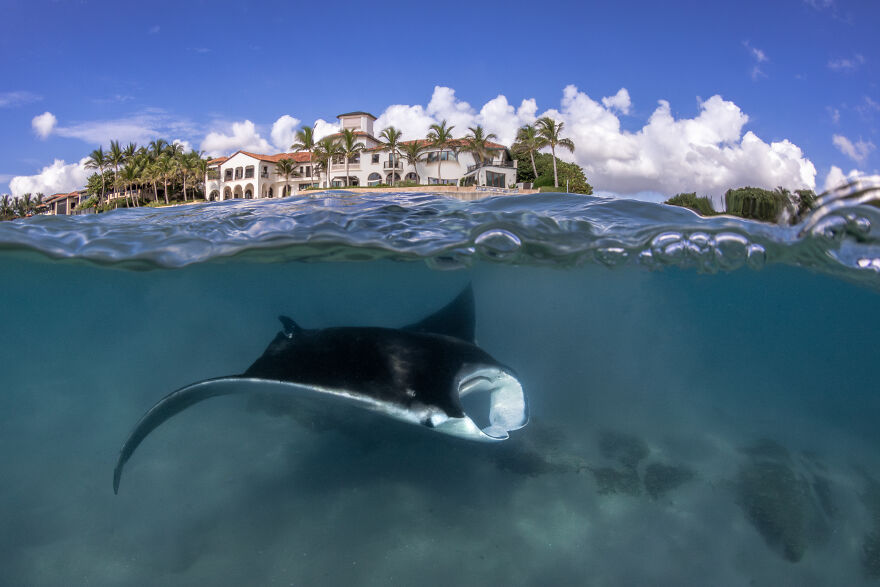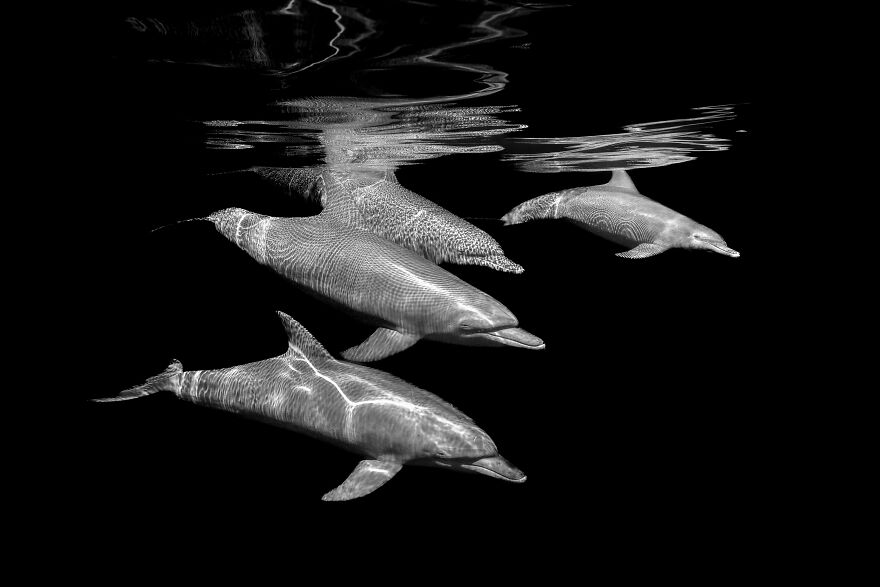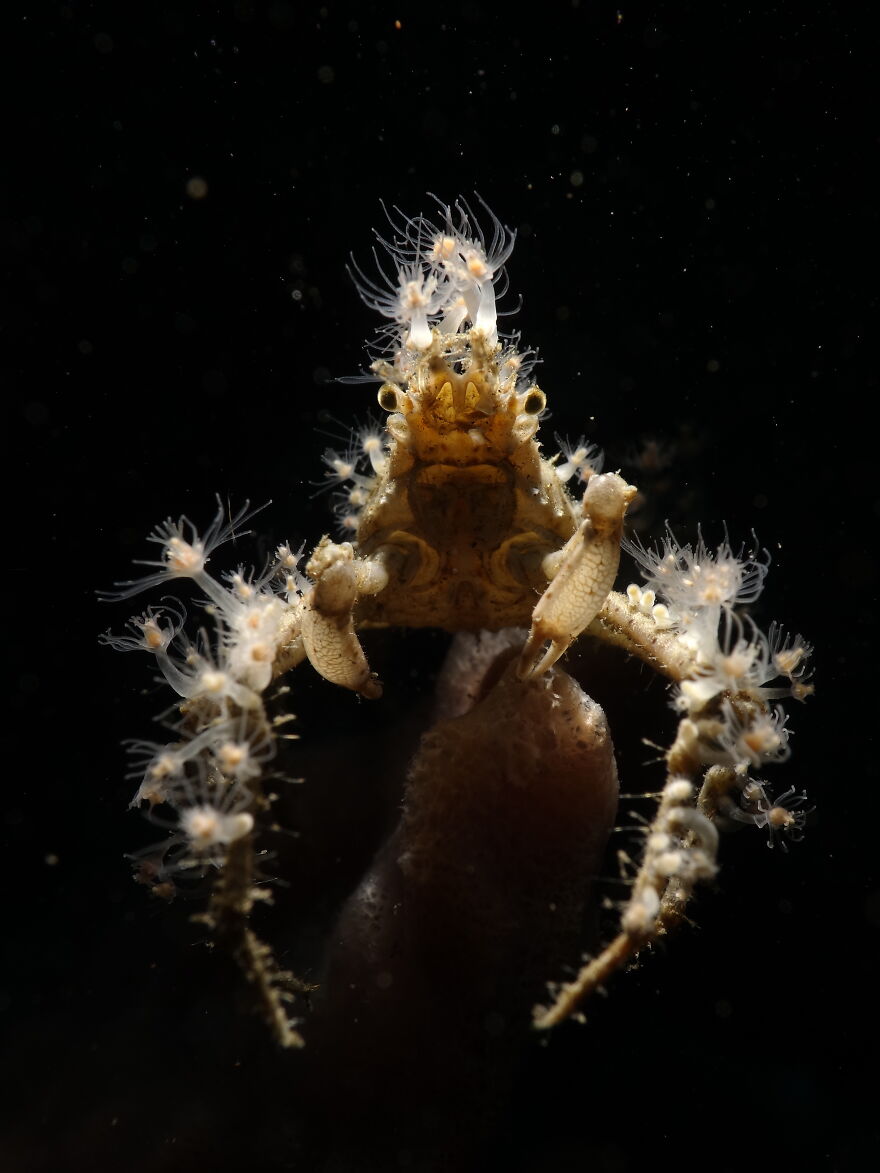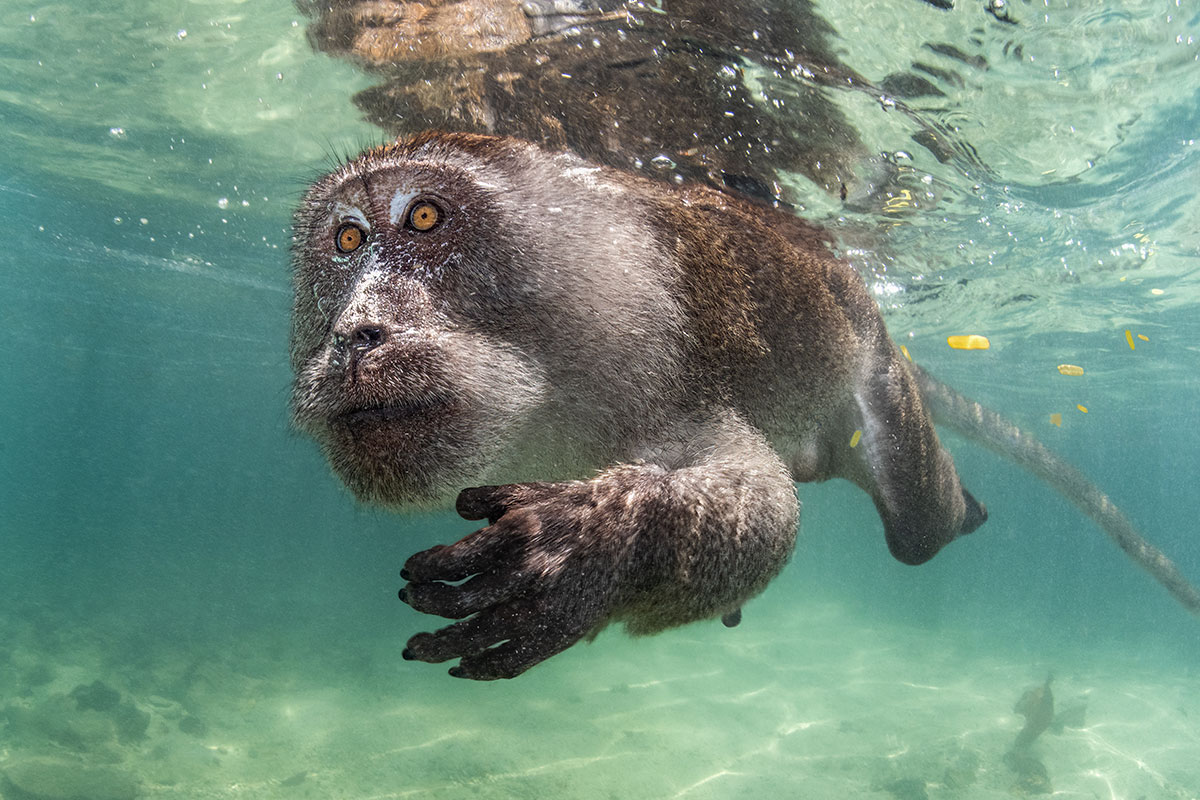
6Kviews
Ocean Art Contest 2023: 30 Images Showcasing Never-Before-Seen Behaviors, Captivating Blackwater Scenes And More
The 2023 Ocean Art Contest winners have been announced by the Underwater Photography Guide! In its 12th year, the competition received images from over 90 countries, celebrating both evolving photography skills and technological advancements.
Winning entries showcased never-before-seen behaviors, captivating blackwater scenes, inspiring messages on ocean conservation, clever lighting techniques, and stunning animal portraits. With 14 diverse categories, the contest provided a challenging platform for photographers of all levels.
Keep scrolling to witness the breathtaking images!
More info: uwphotographyguide.com | Facebook | twitter.com | Instagram
This post may include affiliate links.
Honorable Mention In Marine Life Behavior: "Giving Birth" By Todd Aki
East Coast of Central Sulawesi, Indonesia
"I let my wife choose our last dive of the trip, either an unguided shore dive or a boat dive. Although she loves wide angle sites from the boat, she picked the shore dive. It was because the house reef was on fire! Mimics and wonderpus were so common we stopped pointing them out. There was an explosion of ghost pipefish of varies types. So many different types of frogfish. I saw so many hairy frogfish, I stopped taking pictures of them. I was diving the house reef before sunrise and at night without my wife and she surprisingly, had not seen a hairy the entire trip. This last dive was a quest for us to find her a hairy. The dive did not disappoint. We saw so many different types of cephalopods including a, yawn, mimic. We came across a newly laid patch of squid eggs which strangely, had a seahorse attached. While shooting this unusual combination, a school of razorfish photobombed the picture. We were at the end of the dive when I spotted something that did not make sense. Why was a seahorse in the water column? I could not believe my eyes at what happened next. The seahorse convulsed and out came hundreds of babies. Shooting is always my top priority but I wanted my wife to experience this moment with me so I banged my tank with my muck stick to get her attention and missed the opportunity to fire off a couple of shots. I was able to get into position and got three shots at the male seahorse’s next release. My wife was now at my side and the current took the baby seahorses right next to her mask. There was one more release with just few more babies than the seahorse dropped to the ocean floor exhausted. I was so happy my wife was able to experience this once in a lifetime encounter with me. But we never found her a hairy frogfish."
"Although the AI revolution has quickly changed the global photographic landscape,this year’s winners are a testament to humanity’s creative perseverance over machines. With new rules against the use of regenerative AI imagery in our primary categories, these photos are 100% real," say the organizers of the Ocean Art Underwater Photo Contest.
2nd Place In Portrait: "Octopus Macropus, Polpessa" By Alessandro Raho
Noli, Ligurian Sea, Italy
"This photo was taken in June 2023 at the dive site: "Sabbione delle Meraviglie" in front of Noli in the Ligurian Sea. I immediately identified this cephalopod by its characteristic spotted coat. I have met these animals other times, but they usually tend to run away, however the defense behavior of this subject was different, in fact the animal opened its tentacles to appear more threatening by rising from the seabed with 2 tentacles and widening the other 6."
2nd Place In Nudibranchs: "Cutie Guardian" By Yen-Po Huang
Tulamben, Indonesia
"Costasiella kuroshimae is one of the famous nudibranchs in Tulamben. It has a tiny cute face and beautiful eggs in a perfect circle. I spent two dives waiting for it to creep up to its eggs. It looked like it was defending eggs. If it was, it must be the cutest guardian of all nudibranchs."
The top image of the year shows a special picture of a crab-eating macaque swimming in the ocean. Suliman Alatiqi took this amazing photo after spending weeks planning and documenting. According to the competition organizers, it symbolizes the passion and dedication required to capture the best underwater picture in the world.
2nd Place In Macro Category: "Pygmy Poser" By Byron Conroy
Lembeh Strait, Indonesia
"I have photographed pygmy sea horses for many years, there are a few challenges to shooting them, first the eye contact. To have a relaxed specimen making double eye contact with the camera is very rare, secondly the polyps of the coral are usually closed. In order to get the polyps out I had to be the first person on this sea fan in the morning, I already knew this was a playful specimen from the day before so requested to dive the site at dawn when the polyps were out. And this guy is also pregnant and about to burst, so this trifecta of eye contact, polyps out and pregnant male made it the shot I have been after for many years. There was minimal editing, a little contrast, a slight rotation and very minimal crop were all that was needed, the subject speaks for itself."
Honorable Mention In Portrait: "Belle" By Celia Kujala
Norris Rocks, Hornby Island, Canada
"As I immersed myself in the underwater world at Norris Rocks, I took my time to observe and try to understand the Steller sea lions aiming to capture more meaningful images. This image was captured when a beautiful sea lion swam up to me and stared tenderly into my eyes melting my heart. Steller sea lions are listed as Near Threatened on the IUCN Red List. With this image I hope to ignite a desire within people to protect these extraordinary beings and their ocean home."
Ocean Art 2023 is a celebration of always-changing photography skills and new technology. Nirupam Nigam, who is the Editor-in-Chief of the Underwater Photography Guide and a partner in Bluewater Photo and Bluewater Travel, supervised the competition. He said, "This year's contest focused on how judges make decisions to choose the best underwater photos of 2023. It made us think about the essence of a photo, AI, and AI tools. The winners truly represent genuine photography."
2nd Place In Marine Life Behavior: "Mother's Day" By Josh Raia
Crystal River, Florida, USA
"During the chilly winter months in northern Florida, West Indian manatees congregate in the crystal-clear natural spring waters to keep warm. Temperatures in the surrounding rivers can drop dangerously low so the aquifers act as safe havens where they can rest and raise their young. Manatee mums nurse their calves from just beneath their armpits until they are strong enough to strike out on their own. Over the years I have witnessed what wonderful parents they are, tending to every beck and call of the little ones. This tater tot must have been hungry because it spent most of the day attached to mom! I have also heard that calves hang on to hitch a ride if they are tired of swimming for the time being. The juvenile manatees are very curious, often coming right up to you as long as you are calm and find a respectable distance to patiently observe. The mother will typically swim over and scoop them up if they are getting too close to divers in the water. The springs must be a whole new world for them out there to explore, and I am so thankful for the encounter this year."
Best In Show And 1st Place In Portrait: "Aquatic Primate" By Suliman Alatiqi
Phi Phi Islands, Thailand
"During fieldwork at Phi Phi Islands, Thailand, spanning several weeks, I focused my efforts on documenting the maritime behavior of the Crab-eating macaque with particular focus on their water forages. The macaques have adapted very well to living around the sea and will venture into the water for various reasons including transportation, scavenging, cooling down and playing. Highly efficient swimmers, they can dive for up to half a minute and can cover short distances faster than most humans. This photo offers a rare glimpse of the swimming movement of a male macaque."
The Underwater Photography Guide is the top destination for everything related to underwater photography. It offers valuable tutorials, technique tips, comprehensive gear reviews, exciting international workshops, and the latest breaking news in underwater photography. UWPG is here to assist divers worldwide in reaching their photo and video goals.
4th Place In Black & White: "Shark Constellation" By Enrico Pompei
Raja Ampat, Indonesia
"We found this young whale shark during a diving trip in the south part or Raja Ampat National Park. He spent hours circling around us feeding on small schooling glassfish. I took this photo a few seconds before he vanished in the blue, with the white spots of its livery drawing the silhouette like a constellation."
4th Place In Portrait: "Everything Is A-Ok" By Gabriel Jensen
Lauderdale-by-the-Sea Pier, Florida, USA
"Summer brings calm seas to South Florida where a dedicated community of shore divers heads out nearly every day to survey for cool critters. I was signaled over by my friends, Dewalt and Evelyn who had spotted this lizardfish grappling with a challenge, its eyes perhaps larger than its mouth. The comically calm doctorfish steals the spotlight, displaying a remarkable defense mechanism with splayed pectoral and dorsal spines. Typically, in these images, the lizardfish is the star of the show, but in this case, I rotated the image to emphasize the doctorfish's stoic demeanor, reminiscent of the 'everything is fine' meme."
3rd Place In Blackwater: "Snowy Night" By Jialing Cai
Anilao, Batangas, Philippines
"I captured this image during a blackwater dive a few days after the Taal Volcano eruption in the Philippines in early 2020. This female paper nautilus was hitchhiking on a floating piece of wood debris in the extremely turbid water. It belongs to the octopus genus called Argonauta, one of the few octopi’s lineages that live in the open ocean. The females are unique in having evolved a shell for laying eggs. As I pressed the shutter, the surrounding particles reflected my flashlight in a manner that created the illusion of falling snow. For blackwater photography, we like to place the strobes in an angle and position where the light can shine directly on the subject, ensuring a clean dark background. However, when I initially attempted to capture this Argonaut, I was unaware that the strobes were placed in a “wrong” position. The light was shining on the space between the subject and my camera, which had illuminated the presence of all the surrounding particles. Instead of portraying chaos in the aftermath a natural disaster, these particles evoked an unusual sense of serenity, transforming the scene into a fairytale set on a snowy night.
Blackwater photographers are obsessed with clear water. We are drawn to the pure darkness that mirrors the vacuum of outer space. We tend to forget that the suspended particles which include the sand grains, organic matter and even miniscule organisms are an integral part of the ecosystem. These particles always fade into the background or are simply removed through editing, but they form the foundation of the complex marine food web. If the water were genuinely transparent, there’s no way the ocean could sustain such abundance of life. The “snowflakes” in this captured scene always remind me of these tiny yet ubiquitous existences."
Your photo has provided a great learning experience - I never even had hear the term blackwater before. Thanks!
3rd Place In Portrait: "Fresh Start" By Jules Casey
Mornington Peninsula in Victoria, Australia
"Every year thousands of Giant Spider Crabs come into Port Phillip Bay for their annual molt. They gather in large numbers and shed their old exoskeletons. Once molted they double in size while their new shell hardens over the next couple of days. During this time, they are vulnerable to predators, so they gather tightly in large numbers to reduce the risk of being eaten. This freshly molted Giant Spider Crab stands in front of a group of crabs yet to molt, allowing me the opportunity to take a portrait shot."
Honorable Mention In Black & White: "Just Below" By Serge Melesan
Mayotte Indian Ocean
"A green turtle at the surface of Mayotte lagoon."
Honorable Mention In In Compact Behavior: "Hello" By Keri Frankenstein
Bimini, Bahamas
"As a pod of Bottlenose Dolphin were crater feeding I slowly sunk down a bit and this one came up to say Hello."
1st Place In Wide-Angle Category: "Bunk Buddies" By Suliman Alatiqi
Roca Partida, Mexico
"Whitetip reef sharks are one of few shark species that rest in place. At Roca Partida, a small island, real estate is limited for the many whitetips that live there and they can often be seen bunking together. I wanted to get a photo of all of them facing me and with a lot of patience and a careful approach I managed to do so."
Honorable Mention In Blackwater: "Art" By Steven Kovacs
Manado, Indonesia
"I have seen many larval snails over the course of several years of blackwater diving, but on one particular dive in Manado, Indonesia this particular gastropod caught my eye. I had never seen one so colorful and dazzling before. The snail was in constant motion, but occasionally it would spread out symmetrically in full display for just a brief moment, displaying like a piece of underwater art. As I photographed it for several minutes, I was fortunate enough to able to capture one such pose with this photograph."
1st Place In Nudibranchs: "After The Wedding" By Peter Pogany
Anilao, Batangas, Philippines
"In the past two years I dove in Anilao on three separate occasions. We encountered this species on our first tour and were delighted to find that they were mating. My two diving buddies busied themselves with the nudibranchs, and by the time it was my turn I had no air left. I hardly hoped to get a second chance to observe this special event. But on our third tour I cought them 'in flagranti'."
2nd Place In Coldwater: "Pup Playtime" By Celia Kujala
Lobster Shack, Coronado Islands, Mexico
"California sea lions are born in early summer in the Coronado Islands. Play is very important in their development. By late fall they have grown to be very confident in the water and can often be seen play fighting each other. I watched these two pups swirl around together and playfully bite each other. For now, it is all for fun as they learn skills that will help them later in life."
1st Place In Black & White: "Sealion Playing In Sardine Ball" By Joergen Rasmussen
Magdalena, Baja California, Mexico
"Each November, sardines aggregate offshore the Mexican west coast. This in turn attracts many predators. Working with a local fisherman, we search the deep water offshore near the continental shelf and we spotted a lonely sealion. The sealion was chasing the sardines and the ball was constantly changing shape as the sealion broke it up."
Honorable Mention In Underwater Conservation: "Brainception" By Dan Mele
University of the Virgin Islands, U.S. Virgin Islands
"Most corals spawn once a year in synchrony by using several environmental cues. Due to the ongoing degradation of coral reefs, many surviving corals of the same species are now spaced too far apart on a reef for successful fertilization to occur. At the University of the Virgin Islands, coral researchers temporarily removed several grooved brain corals from reefs surrounding the U.S. Virgin Islands and brought them into a land-based coral nursery, where they're spawned in controlled conditions. These techniques allow researchers to collect sperm and eggs from several corals efficiently and fertilize them in the lab, where they can be grown and eventually outplanted back to the reef. After spawning, the corals removed from the reef are placed back to the same reef which they were collected from.
This technique of assisted fertilization is also sometimes called assisted evolution. The corals inside this table have survived several prior bleaching events, hurricanes, and disease outbreaks, such as the devastating Stony Coral Tissue Loss Disease. This means that these individuals may harbor essential genetics, making them more resilient to several environmental stressors that kill corals. By spawning and crossing these survivors, it's hoped that this may lead to more robust and resilient corals better equipped for the future environmental parameters of our oceans.
Just before they're expected to spawn in the nursery, the water flow is turned off, bringing a calmness to their environment and creating the perfect opportunity to shoot the reflection of the corals in the still water surface. With the corals-filled nursery, I only had a few locations to slip my camera in. Fortunately, this vantage point gave me lots of depth to work within the nursery."
Honorable Mention In Coldwater: "Carp Love" By Ferenc Lorincz
Čierna Voda, Slovakia
"Carp pairs in the Lake, Slovakia."
5th Place In Macro Category: "The Eye" By Guillermo Viveros
Playa del Carmen, Mexico
"I was experimenting with my new Marelux Snoot in a Playa del Carmen reef, about 10-12 meters deep. After a while, I spotted a peacock flounder (Bothus lunatus) on the sandy seabed—a common fish in the area. Initially, it seemed wary of me and my photographic equipment, attempting to evade my presence. However, I carefully trailed it until it grew accustomed to me and my gear. Suddenly, it came to a halt and began surveying the surroundings. While adjusting my snoot and focusing to capture the perfect shot, I managed to take five shots as the flounder patiently waited for me to get it right. Eventually, it darted away and disappeared into the vast ocean. This particular shot is one I consider myself fortunate to have captured, as the flounder allowed me to capture its essence."
Honorable Mention In In Compact Behavior: "Circle Of Life" By Andrea Michelutti
Anilao, Batangas, Philippines
"I found this Favorinus tsuruganus, along with its eggs, on the egg ribbon of the Spanish dancer (Hexabranchus sanguineus). This image captures a stark contrast between nature’s beauty and its harsh realities. The bright colors and intricate designs of the nudibranchs are captivating, but they hide a harsh reality. The nudibranch in the foreground is feeding of the eggs of another of its kind: the ribbon of purple eggs laid by the Spanish dancer fell prey to the Favorinus tsuruganus, which also deposited its white eggs on top.
This scene illustrates intraspecific predation, a phenomenon where an animal consumes another of its own species, typically targeting the eggs or the young. Shooting this image required a great deal of patience, as the constant movement of the purple eggs, caused by the undertow, obscured the nudibranch and its eggs. After some attempts, I succeeded in capturing this vivid portrayal of the ‘circle of life'."
While sad, it's natural and your photograph is is very distinctive.
3rd Place In Compact Macro: "Riding" By Regie Casia
Anilao, Batangas, Philippines
"I noticed the paper nautilus riding on the jellyfish at the end of our dive. I had 30 bar left on my tank. I took some photos and then I exited the water."
1st Place In Marine Life Behavior: "The Birthday" By Kenji Sato
Miura Peninsula in Kanagawa Prefecture, Japan
"Black cardinal fish live in shallow coastal waters, and males raise eggs they receive from females in their mouth (mouth brooder). The eggs hatch in about a week. Until they hatch, males stay still behind a rock and feed the eggs with fresh seawater. At first, I did not know when the eggs would hatch, but after a few observations, I could tell when the eggs would hatch. Hatching occurs within a few hours after sunset. At the moment of hatching, the father swims upward and spits out the babies in an instant. So, it's difficult to take a picture.
It is said that the number of fries in a single hatching is about 20,000, so the moment of hatching is quite impressive. As soon as the babies hatched, they scattered all over the place. I hope that many of the fry will grow up and survive next year."
Honorable Mention In Wide-Angle Category: "Rainbow" By Ipah Uid Lynn
Male, Maldives
"I haven’t seen whale sharks for the longest time. Maldives are known for encountering Whale Sharks. I was very lucky on the first day as I manage to see a few. This one particular whale shark was very friendly. It kept circling around me as I had all the small fishes attracted to my focus lights. I guess for him it was a free buffet as the planktons were a lot that night as well. I stayed there for about an hour until dawn as I wanted the golden light to reflect on the small fishes and it paid off!"
1st Place In Blackwater: "Squid Hunting" By Keigo Kawamura
Japan
"I collect and photograph floating creatures at night, Bonfire style. Many squid and shrimp will gather in the underwater torch. The squid in the photo is known to be the smallest in the world, and the pygmy squid successfully preyed on a shrimp as large as its own body. Pygmy squid eat shrimp by inserting their mouths into the gaps between their shells."
I love shrimp myself, but never do they look more like “bugs” than alive and in water. The transparency doesn’t look like it would inspire me to try eating it. And I’m incredibly catholic in my tastes. Two foods I reject. The look of raw oysters is gruesome. When I was a teenager, my boyfriend’ high tone company gave a Christmas party. We got food (MUCH younger than the other guests), went and sat on a bench to eat. Back to back, to the cause of much laughter. Back to back, he ate his raw oysters and I chowed on my steak tartare. (Yes, raw cow). At least raw cow doesn’t look like snot! And the other food, you might succeed in tricking me into trying but, otherwise, oh HEL no I’m not eating Rocky Mountain Oysters! (Bull testicles). Of course, the testicles my be all bull, but, the bull isn’t very bullish anymore!
Honorable Mention In Macro Category: "Eye See You" By Keith Mash
Bunaken Island, Sulawesi, Indonesia
"During my years in Jakarta, Lembeh emerged as our prime spot for critter and macro photography. On a particular expedition, we extended our journey to the islands of Bangka and Bunaken. Little did we know, Bunaken is home to a sizeable green turtle population.
During my years in Jakarta, Lembeh emerged as our prime spot for critter and macro photography. On a particular expedition, we extended our journey to the islands of Bangka and Bunaken. Little did we know, Bunaken is home to a sizeable green turtle population.
A 90mm macro lens would not be my first choice to photograph turtles! My previous attempts at capturing close-ups of turtles, when I have been lucky enough to find one have always been thwarted. Invariably I have found them skittish despite my cautious approach. With this in the back of my mind, I focused on critter hunting along the wall, as the rest of my party enjoyed the turtle activity and what seemed like endless turtle fly-bys.
As luck would have it towards the end of the dive, I spotted a large green turtle nestled in the wall. It seemed to be observing us from afar and showed no signs of swimming off. With slow movements I managed to get within macro range and cautiously maneuvered my camera into position waiting for the right moment. To my surprise the turtle turned its head and gazed directly into the camera as if to check me out. As its eye came into focus, I paused; me looking at the turtle, the turtle looking at me…click… it was done.
On the dive that I obtained this shot, there were only 3 divers in our group, all highly respectful of marine life. This was a unique moment for us all where the turtle was clearly comfortable around us and not skittish in any way allowing me to capture what for me is one of my favorite shots which says 'Eye See you'."
3rd Place In Wide-Angle Category: "In Our Shadow" By Bryant Turffs
Florida, USA
"Over the past seven years of studying juvenile manta rays in Florida with my partner, marine biologist Jessica Pate, capturing images that illustrate the impact that our world has on these rays has been a priority for me. Easier said than done. Photography usually takes a backseat to science during our field days and Florida's mantas do not behave like mantas elsewhere in the world. They are seldom seen on traditional dive sites and are sparsely populated. On this occasion I was lucky to encounter a tolerant individual in shallow water, which allowed me to capture this split shot of a mansion looming over a juvenile manta named Cricket. Manta rays are listed as endangered by the IUCN, and are listed on the US Endangered Species Act. While they are protected from harvest in Florida waters, they still suffer many anthropogenic impacts along our densely populated coast. Twenty five percent of the rays in our study have been sighted while entangled in fishing lines and eight percent have suffered boat strikes. Further, it is hard to say what impacts coastal development and pollution have on these rays. As the first dedicated long-term study of Florida's manta rays, our Florida Manta Project team seeks not only to gather baseline scientific information, but also to conduct outreach and conservation to protect these rays. This includes educating the public about best practices for fishing around mantas, boating in their vicinity, and limiting disruptive in-water activities like tourism that could negatively impact this vulnerable population. "
3rd Place In Black & White: "Dress For The Sea" By Serge Melesan
Mayotte Indian Ocean
"Tursiops dolphins living just below the surface in the Mayotte lagoon. This photo shows them as a family and as social animals with a hierarchy. The best place to see them is in the Ocean. It's a magical encounter when they accept you in their environment."
2nd Place In Compact Macro: "Radioactive" By Marcus Commodore
Bali, Indonesia
"For the first time in what felt like a lifetime, I was back in the water. After the years of restrictions and being separated geographically from my passion, I booked my ticket and headed to Bali. It was a rush, feeling the sensations of those first few dives, but also being reunited with my well-worn camera and housing.
The northern shores of Bali have always held a special place in my heart, so naturally I wound up there. After doing several dives around Amed, I found a great dive shop and did a few exploration dives with them. On one of the dives, I found this decorator crab on an enormous barrel sponge at the bottom of a barren slope. Sitting at roughly 30m and completely shrouded in darkness, owing to the depth and overcast conditions, this usually nocturnal species of crab was perched relatively exposed.
I have had an idea for a few years now to use a pair of snoots on this type of subject to backlight and isolate the anemones on its back, while using just a touch of light to illuminate the eyes and “face.” While it took a few shots and some adjustments – especially to get the subject's eyes in focus, the hardest aspect was to isolate the subject from the background of the barrel sponge.
Finally, after a lot of twisting and turning the camera to get the background out of the photo and the subject in frame with the proper lighting, I left this crab to continue its exploration of the sponge- having happily taken some photos showing the beauty of this tiny and cryptic animal."
Note: this post originally had 72 images. It’s been shortened to the top 30 images based on user votes.
